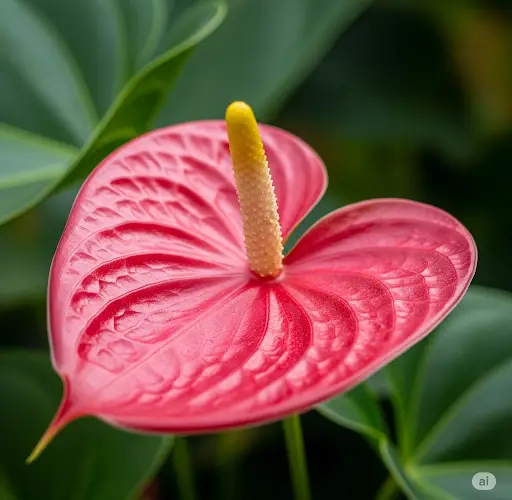Anthuriums, often called “flamingo flowers” or “laceleaf,” are prized for their vibrant, long-lasting blooms and striking foliage. But like any tropical houseplant, Anthuriums can suffer when their roots outgrow their pot or the soil becomes compacted and exhausted. If your Anthurium is drooping, not flowering, or showing signs of root problems, an urgent transplant might be the key to saving it.
In this guide, you’ll learn how to properly transplant Anthurium, which soil mix to use, how to encourage healthy root development, and what kind of watering routine will support recovery and vigorous growth.
When Does Anthurium Need Transplanting?
While Anthuriums are relatively low-maintenance, they benefit from repotting every 1–2 years. Urgent signs that your plant needs immediate transplanting include:
-
Yellowing or curling leaves
-
Roots growing out of the drainage holes
-
Soil that dries too quickly or stays soggy
-
Foul odor from the pot (indicating root rot)
-
No new growth or flowering for months
If you notice any of these symptoms, it’s time to act quickly.
Choosing the Right Pot
Always choose a pot that is just one size larger than the current one. Oversized pots hold excess moisture, which can lead to root rot. Make sure the new container has ample drainage holes.
Best material: Terracotta or ceramic pots are ideal because they allow better air circulation and moisture regulation.
The Ideal Soil for Anthurium
Anthurium roots need a loose, airy, and nutrient-rich soil mix. Standard potting soil alone is too heavy and retains moisture excessively, which can lead to root suffocation.
Recommended soil mix:
-
1 part orchid bark or pine bark
-
1 part perlite or pumice
-
1 part coconut coir or peat moss
-
A handful of activated charcoal (optional, to keep the mix fresh)
This mix ensures excellent drainage, prevents root rot, and mimics the plant’s native tropical habitat.
Step-by-Step Transplant Instructions
-
Prepare the new pot and soil mix. Moisten the mix slightly before use.
-
Carefully remove the Anthurium from its current pot. Gently tap the sides and slide the plant out while supporting the base.
-
Inspect the root system. Trim off any black, mushy, or rotten roots with clean scissors. Healthy roots should be firm and light-colored.
-
Apply a root stimulator (optional but helpful). Dip the roots into a diluted solution of a natural root stimulator or sprinkle with a bit of cinnamon powder to prevent infections.
-
Place the plant in the new pot. Position it so that the crown (where stems emerge) sits just above the soil level.
-
Backfill with the soil mix. Gently press down without compacting it too much.
-
Water lightly to help the soil settle and activate root growth.
Natural Root Growth Stimulants
To encourage rapid recovery and new root development, consider using natural stimulants. These include:
-
Aloe vera juice: Dilute one tablespoon in 1 liter of water.
-
Honey solution: One teaspoon per glass of water acts as a gentle rooting tonic.
-
Willow water: Made by steeping young willow branches in water—great for stimulating root cell activity.
Use one of these solutions during the first two or three waterings post-transplant.
Proper Watering After Transplant
Overwatering is a common mistake, especially right after transplanting. Anthuriums like to be watered only when the top 2–3 cm of soil are dry.
Watering tips:
-
Water early in the morning.
-
Use lukewarm, settled water.
-
Never allow the pot to sit in standing water.
-
Reduce watering frequency during cooler months or in low-light conditions.
For the first week post-transplant, mist the leaves lightly to maintain humidity and reduce stress.
Aftercare and Monitoring
After transplanting:
-
Keep the plant in a warm location with bright, indirect light.
-
Avoid fertilizing for 3–4 weeks to give roots time to adjust.
-
Maintain indoor humidity at 60% or higher. Use a humidity tray or humidifier if needed.
-
Watch for signs of new leaf growth, which indicates successful adaptation.
Common Mistakes to Avoid
-
Using dense or garden soil that retains too much moisture.
-
Transplanting into a pot that’s too large.
-
Watering too heavily immediately after repotting.
-
Exposing the plant to direct sunlight post-transplant.
Avoiding these mistakes will improve your plant’s recovery time and ensure a successful transition.
Conclusion
If your Anthurium is showing signs of stress, drooping, or halted growth, don’t delay—a proper transplant could save and even rejuvenate your plant. By choosing the right soil, applying gentle root stimulators, and adjusting your watering routine, you’ll support the plant through recovery and set the stage for lush foliage and vibrant blooms.
Anthuriums are resilient plants that respond quickly to the right conditions. With this urgent care approach, you can breathe new life into your flamingo flower and enjoy its tropical beauty for seasons to come.



